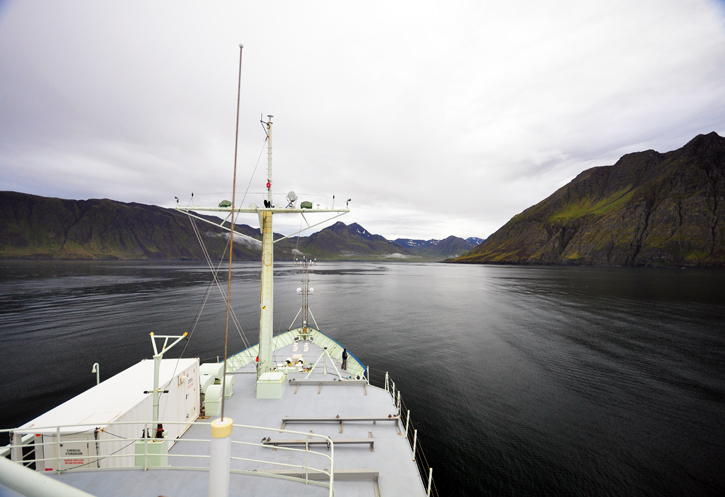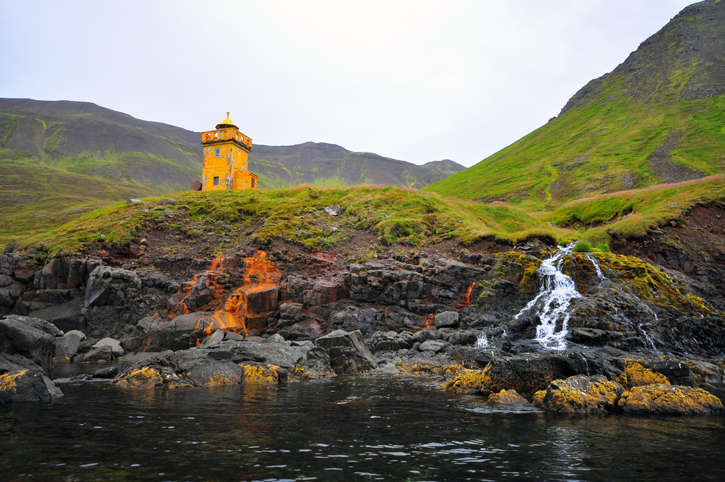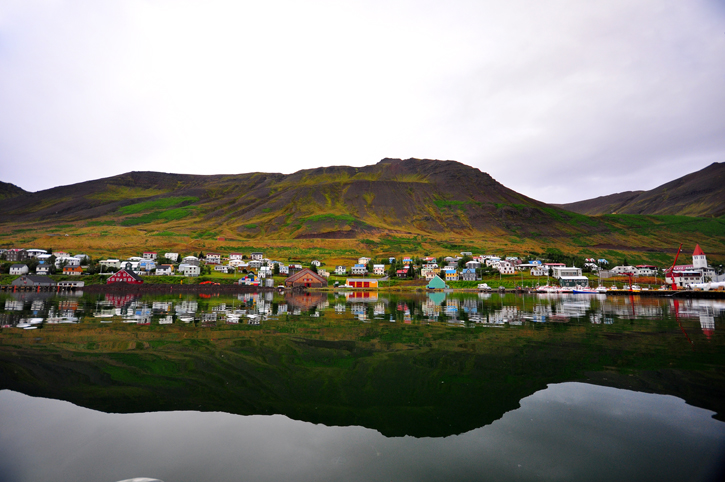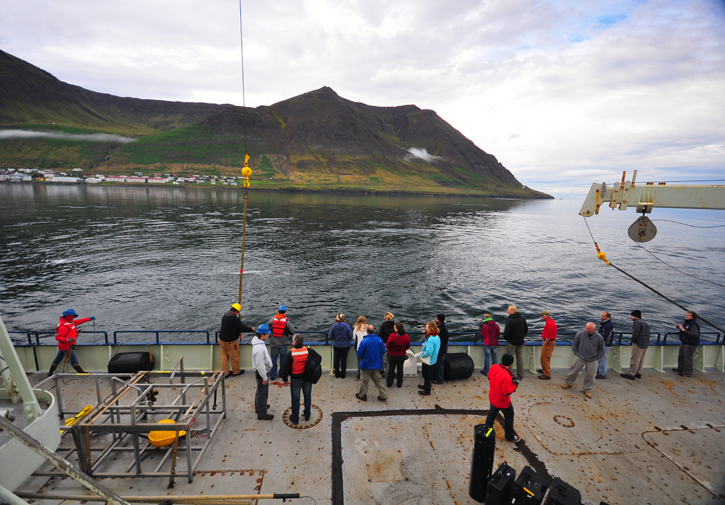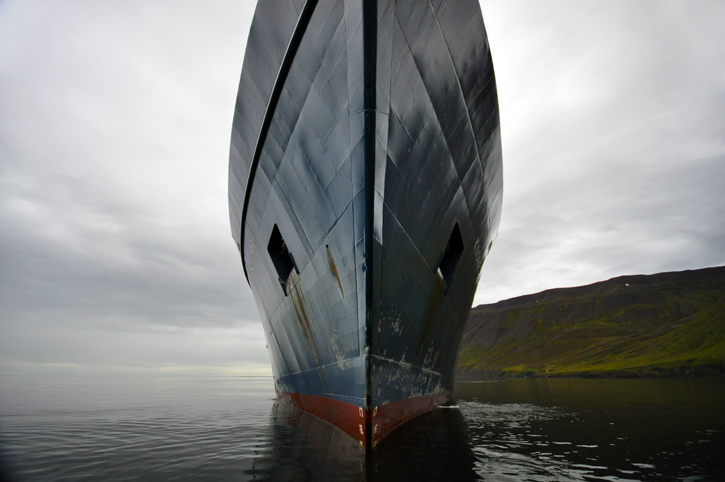August 28, 2011The high, serrated north coast of Iceland hoved into sight before breakfast. The wind was slack, seas glassy, about eight shades of gray in the clouds. As we approach within several miles, the mountains resolved themselves into individual peaks and cliffs patched with greenery and sliced by thin, silvery waterfalls. The moorings, the focus of the cruise so far, have all been deployed across the Denmark Strait ahead of schedule, thanks to the fortunate spate of fair weather. The aft deck, so recently covered by mooring balls, spools of oceanographic wire, stacked anchors, and crates of miscellaneous hardware, looks now like a dance floor. It’s kind of sad, however. It means that seven of our shipmates, their work complete, are leaving us in a few hours.
The Knorr noses in gently into Siglufjordur. © Rachel Fletcher Friendships form quickly on these cruises. It always happens. Sometimes we keep in touch or meet again ashore, but the context—the close quarters and shared objectives of shipboard life—that accelerated friendship are absent. The Icelandic oceanographers will be leaving, so too the Dutch; Jim and John, the mooring specialists, and Rob, the National Geographic cameraman, who has become part of the team, will be going ashore. We’ll miss them all, at least until the new routine takes hold. The starboard-side deck is now lined with their luggage and scientific equipment. There isn’t much flat land in northern Iceland to accommodate human habitation or mobility. Away off the starboard bow, we see a tiny, utterly isolated farmstead barnacled to a narrow footing at the base of the cliffs. Standing at the rail watching his country, Hedinn nodded toward the farm and said, “A hundred and fifty years ago my forebears lived there.” Reading The Fish Can Sing by the Nobel laureate Halldór Laxness on this trip, I’ve grown interested in the rural life in Iceland and the dryly hilarious Icelandic sense of humor, evinced by Laxness in his book and Hedinn in person over the last ten days. A road ran between the little farm and the shore then disappeared into a tunnel through a buttress in the cliff side. These tunnels, built in the 1960s, made the shore road possible, he said, and thus relaxed the isolation of life in the outlying villages. I’ll miss his wit and his sense of irony.
The plan was to drop our departing shipmates in the little town of Siglufjördur at the apex of a glacier-carved notch in the coast; from there they’d travel by car to Reykjavik and then to their separate ways. Dead slow, Knorr nosed into the short fjord between the jaws of two near-vertical cliffs, the scent of fish in the air. Now in late August, there were only scant remnants of snow in depressions at the higher altitudes, no ice on the cliffs or in the sea (September is the ice minimum in the Arctic). But the evidence of ancient ice is everywhere imprinted on the landscape, in cirques and arêtes and glacier-carved passes through the pointed mountains. You can almost see the Pleistocene ice carving up the landscape and plowing great portions of it into the sea. “Kick it up 150 RPMs,” said the Skip to Jose at the helm.” “One fifty,” he replied. “The jetty’s in sight,” said Second Mate Jen looking through the binocs. “And there’s an object in the water. It looks like a mooring.” “Let’s bring down the bow thruster.” Jen phoned the engine room to request the bow thruster. Knorr isn’t powered like a typical ship with two or more fixed propellers on the stern. Her job requires her to stop in the open ocean while scientists measure it by various means. Therefore, she’s powered by twin stern-mounted “thrusters,” propellers that can pivot 360° to deliver thrust in any direction and any combination. Plus, she has that thruster in the bow, which when not in use is retracted into the hull. When lowered, it too can pivot in a complete circle. So if all three thrusters are aligned such to direct thrust toward the center of the hull, she’ll remain stationary. It’s not quite that simple when ocean forces, wind and current, are exerting themselves on the ship, but today in flat calm, it was easily that simple. And that was the plan for today, to use the three thrusters in lieu of an anchor. There was an ample wharf in town, but not enough water to accommodate Knorr’s 16.5-foot draft (23 feet with the bow thruster down). So our people were to be shuttled ashore in the RHIB.
Goodbyes and hugs to those who leave and happy gathering for small boat rides. © Rachel Fletcher Those of us staying aboard helped them load their gear; then we hugged them goodbye. Three trips later, they were away, and ship felt empty. Then the Skip offered to take whoever wished to go for boat rides around the fjord and the waterfront town—just for fun. We all appreciated that and respected him for the offer and Bob for the time. But as Catie, one of the two-member Shipboard Science Support Group (SSSGs), said, “That’s one reason why people go to sea in research ships.” Paul, one of the ABs, was driving the RHIB when I went for a ride, and he had a bit of nautical business to conduct: The Skip hates it if, when entering port, his ship carries the slightest list, or side-to-side imbalance. You measure list using the “plimsoll marks,” white numbers painted, usually, near the bow indicating the depth between the waterline and bottom of the hull. Paul stopped on both sides of the bow and by radio read the numbers to Kyle the bosun. The numbers are precisely six inches high, so it’s possible to read the marks with a degree of accuracy. If the numbers on both sides of the ship match, then she’s riding “on an even keel,” just the way the Skip likes it. She was. So off we went for a delightful boat ride. That’s why people go to sea on research vessels, as the lady said, and why I feel this real emotional attachment to Knorr and her people.
Even keel. © Rachel Fletcher We were underway by mid-afternoon bound west back toward the Greenland coast and our second chance to see the big island while conducting serious ocean science. There’s a potential problem looming, however. Remnants of Hurricane Irene have formed into a rather deep area of low-pressure right on our track. The Danish Meteorological Institute is calling for gale-force winds, maximum 40 knots, with seas around 15 feet for Friday and Saturday. That’s not enough to scare this ship, but it’s easily enough to bring sea ice down from northeast Greenland, blocking both the science and the sightseeing. By dinnertime, Iceland had vanished astern as we steamed for Greenland—and the new weather. Last updated: December 27, 2011 | ||||||||||||||
Copyright ©2007 Woods Hole Oceanographic Institution, All Rights Reserved, Privacy Policy. | ||||||||||||||


